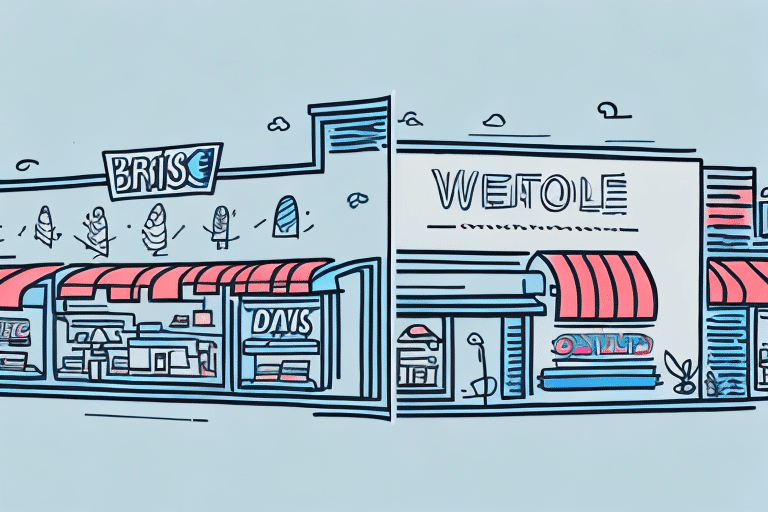Maximizing Success Through Retail Partnerships
In today's competitive business landscape, companies must explore diverse avenues to expand their customer base and increase revenue. One effective strategy is through retail partnerships, where two or more businesses collaborate to offer products or services to consumers. This article delves into the intricacies of retail partnerships, examining their benefits, how to identify the right partner, building strong relationships, measuring success, overcoming common challenges, best practices, real-life case studies, future trends, and leveraging social media and technology to enhance partnerships.
Understanding Retail Partnerships
Retail partnerships involve collaboration between companies to sell their products or services jointly. These partnerships can manifest in various forms, including exclusive retailer-distributor agreements, joint ventures, and co-branding opportunities. The core advantage lies in the ability to reach new customers, generate excitement around offerings, and boost revenues through shared expertise and resources.
For instance, the collaboration between Nike and Apple resulted in the creation of the Nike+ app, which integrates athletic wear with wearable technology, enhancing the user experience for fitness enthusiasts. This partnership not only expanded Nike's reach into the tech-savvy market but also provided Apple with a niche product that appeals to a specific consumer segment.
Benefits of Retail Partnerships
Expanded Customer Base
Partnering with a well-established retailer allows companies to tap into new customer segments. By leveraging the partner's existing customer base and market reputation, businesses can efficiently promote their products or services to a broader audience.
Resource Sharing
Retail partnerships enable access to a wider range of resources, including marketing support, supply chain optimization, and distribution networks. Sharing resources can lead to cost reductions and increased operational efficiency.
Enhanced Marketing and Brand Exposure
Collaborative marketing campaigns can create greater buzz and brand recognition. Joint initiatives often result in more impactful advertising efforts, benefiting both partners by increasing their market visibility.
Risk Mitigation
Entering new markets or launching new products carries inherent risks. Retail partnerships allow businesses to share these risks, making ventures into unfamiliar territories more manageable and less financially burdensome.
Identifying the Right Retail Partner
Alignment of Goals and Values
Choosing a partner with compatible business objectives and values ensures a harmonious collaboration. It's essential to assess whether the potential partner shares similar visions for growth and customer engagement.
Market and Customer Demographics
Analyze the market segments and customer demographics of potential partners to ensure alignment with your target audience. A partner catering to a demographic that overlaps with or complements your own can lead to more effective collaborations.
Financial Stability
Ensure that the prospective partner has a solid financial standing. Reviewing financial statements and credit histories can help assess their ability to fulfill commitments and invest in joint initiatives.
Complementary Strengths
Seek partners whose strengths complement your own. For example, a company with robust product development capabilities partnering with a retailer that has an extensive distribution network can create a synergistic relationship.
Building and Maintaining Strong Relationships
Effective Communication
Regular and transparent communication is the cornerstone of a successful partnership. Establish clear channels for sharing expectations, progress updates, and addressing challenges promptly.
Trust and Reliability
Building trust involves consistent reliability and integrity from both parties. Trust fosters a collaborative environment where partners feel confident in each other’s commitments and actions.
Mutual Benefits
Ensure that the partnership offers benefits to both parties. A win-win scenario motivates both businesses to invest time and resources into the partnership, driving mutual growth and success.
Providing Support and Resources
Supporting your partner with necessary resources, such as training programs or marketing materials, demonstrates commitment and facilitates joint success.
Measuring the Success of Retail Partnerships
Defining Key Performance Indicators (KPIs)
Establish clear KPIs to evaluate the effectiveness of the partnership. Common metrics include sales growth, market share expansion, customer acquisition rates, and return on investment (ROI).
Regular Performance Reviews
Conduct periodic assessments to review progress against KPIs. These reviews help identify areas of strength and opportunities for improvement, ensuring the partnership remains on track.
ROI Analysis
Analyzing ROI helps determine whether the benefits of the partnership justify the costs involved. Tracking ROI over time provides insights into the long-term viability and profitability of the collaboration.
Feedback Mechanisms
Implementing feedback systems allows both partners to share insights and suggestions, fostering continuous improvement and adaptation to changing market conditions.
Overcoming Common Challenges in Retail Partnerships
Misaligned Objectives
Conflicting goals can strain partnerships. It's crucial to ensure that both parties have aligned objectives and a shared understanding of the partnership's purpose.
Cultural Differences
Differences in corporate culture can lead to misunderstandings and conflicts. Promoting cultural awareness and mutual respect helps mitigate these issues.
Communication Breakdowns
Ineffective communication can hinder collaboration. Establishing clear communication protocols and regular check-ins can prevent misunderstandings and keep the partnership cohesive.
Resource Allocation
Disagreements over resource distribution can create tension. Clearly defining roles, responsibilities, and resource commitments from the outset ensures balanced contributions from both partners.
Best Practices for Successful Retail Partnerships
Clear Agreement and Documentation
Drafting comprehensive agreements that outline each partner's roles, responsibilities, and expectations is essential. Clear documentation helps prevent disputes and provides a reference for resolving conflicts.
Flexibility and Adaptability
Markets are dynamic, and partnerships must be flexible to adapt to changes. Being open to evolving strategies and approaches ensures the partnership remains relevant and effective.
Continuous Improvement
Regularly seeking ways to enhance the partnership fosters innovation and keeps both parties engaged. Encouraging creative solutions and joint problem-solving can lead to breakthroughs and sustained success.
Leveraging Technology and Data
Utilizing data analytics and collaborative tools can enhance decision-making and streamline operations. Technology facilitates better communication, tracking of KPIs, and overall partnership management.
Case Studies: Successful Retail Partnerships
Nike and Apple
The Nike+ collaboration with Apple exemplifies a successful retail partnership. By integrating Nike's athletic wear with Apple's technology, the partnership created a product that appealed to fitness enthusiasts and tech users alike, enhancing the user experience and expanding both brands' reach.
Starbucks and Spotify
Starbucks partnered with Spotify to create a unique music experience in Starbucks stores. This collaboration allowed customers to influence in-store playlists through the Spotify app, enhancing customer engagement and blending Starbucks' ambiance with Spotify's music streaming service.
Adidas and Parley for the Oceans
Adidas teamed up with Parley for the Oceans to produce footwear made from recycled ocean plastic. This partnership not only advanced Adidas' sustainability goals but also raised awareness about ocean pollution, resonating with environmentally conscious consumers.
Future Trends in Retail Partnerships
Increased Use of Artificial Intelligence and Data Analytics
AI and data analytics will play a pivotal role in optimizing retail partnerships. These technologies enable partners to better understand consumer behavior, personalize offerings, and enhance operational efficiencies.
Cross-Industry Collaborations
We can anticipate more partnerships that transcend traditional industry boundaries. Such collaborations can lead to innovative products and services that cater to a broader range of customer needs.
Sustainability and Ethical Partnerships
As consumers become more environmentally and socially conscious, partnerships focused on sustainability and ethical practices will gain prominence. Collaborative efforts to promote green initiatives can strengthen brand reputation and appeal to like-minded customers.
Leveraging Social Media and Technology
Enhancing Brand Visibility
Social media platforms offer unparalleled opportunities for partners to amplify their reach. Joint social media campaigns can increase brand visibility and foster a stronger connection with the target audience.
Data-Driven Decision Making
Utilizing data from social media interactions and other digital channels allows partners to make informed decisions. Data-driven insights can guide marketing strategies, product development, and customer engagement efforts.
Collaborative Tools and Platforms
Adopting collaborative tools like cloud-based project management software facilitates seamless communication and coordination between partners, especially in geographically dispersed collaborations.
Creating Win-Win Situations
The most successful retail partnerships are those that deliver mutual benefits. By identifying complementary strengths and shared goals, partners can create offerings that are more valuable together than they would be individually. This synergy not only drives innovation but also ensures sustained growth and profitability for both parties.
Conclusion: Maximizing Success Through Strong Retail Partnerships
Retail partnerships, when strategically planned and effectively managed, can significantly enhance a company's market presence and revenue streams. By carefully selecting compatible partners, fostering strong relationships, leveraging technology, and continuously measuring performance, businesses can create thriving collaborations. In an ever-evolving retail landscape, robust partnerships serve as a powerful catalyst for sustained success and competitive advantage.




















